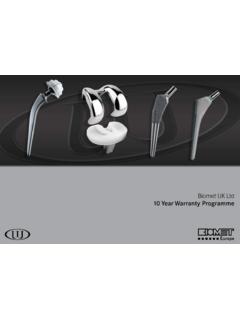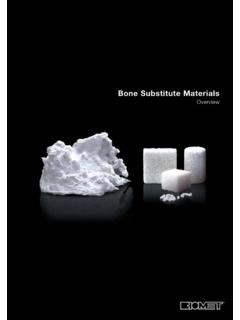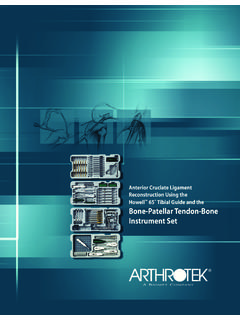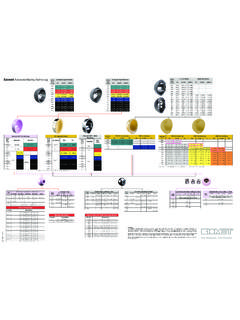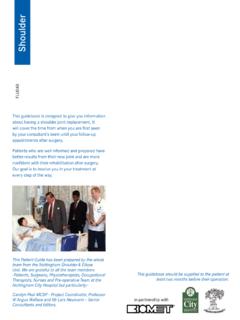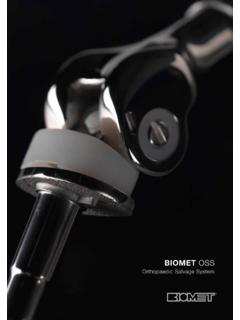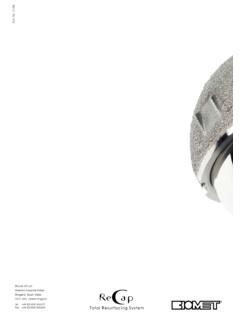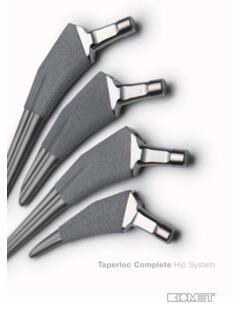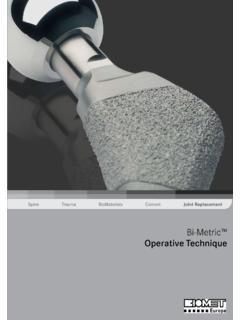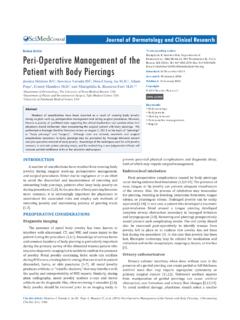Transcription of M2a-Magnum™ Operative Technique - Biomet UK
1 FLH171 08/08. Biomet UK Ltd Waterton Industrial Estate Bridgend, South Wales CF31 3XA, United Kingdom T: +44 (0)1656 655221. F: +44 (0)1656 645454. M2a-Magnum . Operative Technique Magnum Large Shell Articulation Disclaimer Biomet UK Ltd, as the manufacturer of this device, does not practice medicine and does not recommend any particular surgical Technique for use on a specific patient. The surgeon who performs any implant procedure is responsible for determining and utilising the appropriate techniques for implanting the prosthesis in each particular patient. Biomet UK Ltd is not responsible for selection of the appropriate surgical Technique to be utilised for an individual patient. ReCap is a trademark in the 3.
2 Operative Technique 1. Pre- Operative planning Selection of the correct components is attained through careful pre- Operative planning. This can be achieved manually by means of x-ray templates, or digitally by means of a PAC system. Manual pre- Operative planning The M2a-Magnum Hip System provides a comprehensive selection of femoral and acetabular x-ray templates. These templates are positioned over the Anterior Posterior x-rays to best decide the correct implant size required to help restore the patient's natural anatomy. Digital pre- Operative planning The M2a-Magnum System digital templates are available through various digital template providers. When using digital templating for a primary THR, it is necessary to use a magnification marker with a known dimension.
3 This is required in order for the PAC system to calculate the correct magnification. As soon as the correct magnification has been determined, the PAC system can be used to best decide the correct implant size required to help restore the patient's natural anatomy. 4. Magnum Large Shell Articulation 2. Surgical exposure The M2a-Magnum femoral component can be implanted using any of the standard approaches for total hip replacement. The aim of the approach selected is to provide adequate visualisation of both the acetabulum and proximal femur. (Figure 1). Figure 1. 3. Acetabular Preparation and Implant Insertion Prior to commencing acetabular preparation, it is recommended that the femoral head and neck be resected as per instructed in Operative Technique for femoral component to be implanted.
4 Once the femoral head has been resected, it is possible to commence acetabular preparation. (Figure 2). It is important to note that the M2a-Magnum . acetabular component is a hemispherical design, and therefore requires the acetabulum to be under reamed in order to achieve stable fixation. Figure 2. 5. Operative Technique 3a. Acetabular Reaming Standard preparation of the acetabulum should commence at this point. It is important to start reaming with the smallest diameter grater reamer available, perpendicular to the acetabulum in order to find the true acetabular floor. Sequential reaming then follows, ensuring that the reamer handle is angled at the same orientation of the component to be implanted. (45 degrees of inclination and 20 degrees of anteversion) Care must be taken at this stage to ensure that the anterior and posterior columns of the acetabulum are not eroded, as this will affect the overall stability of the component.
5 It is recommended that the acetabulum should be Figure 3. reamed either 1mm or 2mm smaller, depending on bone quality, than the acetabular component to be implanted. (Figure 3). 3b. Acetabular Gauging After reaming, the acetabulum is gauged for sphericity and size, using the acetabular gauges provided. These gauges contain windows that allow direct visualisation of the acetabular floor and also test the stability of the acetabular component prior to implanting the actual acetabular component. The gauge selected should correlate directly with the size of acetabular component to be implanted. (For example, a 56mm acetabular implant requires the Figure 4. acetabulum to be reamed to 54mm diameter. This 54mm reamed acetabulum is then gauged with a 56mm gauge).
6 (Figure 4). 6. Operative Technique 4. Acetabular component impactor assembly Once happy with the acetabular component size, the components corresponding impaction plate should be selected for assembly onto the impaction handle. Before assembling the impaction handle to the impaction plate make sure the ball bearing bushing Figure 5. is visable at the tip of the handle. Figure 5. If the ball bearings are not visible, unscrew the strike plate until resistance is felt and pull the bushing out. If the ball bearings are not completely visible, once assembled, the impactor plate will not engage with the cup. Correct assembly of the impaction handle and impaction plate is achieved by aligning the impaction plate with the tip of the handle so that the slots are aligned.
7 Figure 6. Care should be taken not to push the ball bearings back into the shaft of the impaction handle. Engage the handle with the impactor plate by pushing the two parts together against a hard surface. Figure 7. Figure 6. Confirm that the two parts are flush together and therefore fully seated. Figure 7. The acetabular component is mounted onto the impaction plate and handle by aligning the fingers of the impaction plate over the cut outs on the peripheral edge of the acetabular component Figure 8. Once aligned the cup is secured to the handle by turning pulling the strike plate towards yourself and turning it in a clockwise direction until hand tight. Fig ure 9. The cup is now ready to be impacted into the acetabulum.
8 Figure 8. Figure 9. 7. Operative Technique 4a. Acetabular component insertion Once the acetabular component has been securely locked onto the impaction handle the ReCap acetabular component is impacted into the prepared acetabulum at an angle of 45 degrees of inclination and 20 degrees of anteversion. When correct component seating has been achieved the impaction handle should be removed from the cup. This is achieved by turning the strike plate one-quarter turn anti-clockwise. (Figure 10). Should there be the need to carry out additional Figure 10. impaction of the acetabular component, size specific cup impactors are available on the ReCap instrumentation tray. (Figure 11). To remove the strike plate from the impaction handle, unscrew the strike plate until you fell resistance.
9 Lever the impactor plate from the inserter handle with the multi-tool. (Figure 12). Figure 11. Figure 12. 8. Magnum Large Shell Articulation 5. Femoral preparation and Implant Insertion The femur should be prepared as per instructed in the Operative Technique for the femoral component selected. Once the femoral component has been implanted and the surgeon is satisfied with the component position, it is possible to carry out a full trial reduction of the hip joint. (Figures 13 &14). Figure 13. The M2a-Magnum trial modular heads are available in 12 diameters, each corresponding to the diameter of acetabular component implanted. One must remember that each modular head is 6mm smaller than the acetabular component.
10 For example, a 50mm diameter acetabular component requires a 44mm diameter modular head. In order to be able to achieve a stable joint, the trial necks that are used in conjunction with the trial Figure 14. heads are available in various neck lengths. These different neck lengths allow precise reconstruction of the joint, therefore reducing the chance of leg length discrepancies. (Figure 15). For femoral components with a Biomet type 1 taper, the trial necks are available in 6 different neck lengths (-6mm, -3mm, 0mm, +3mm, +6mm, +9mm), whilst for 12/14 taper components the trial necks are available in 4 different neck lengths (-2mm, 0mm, +4mm, +8mm). (Figure 16). Whatever femoral component is employed, the aim of the trial head and neck is to allow the precise trial Figure 16.

